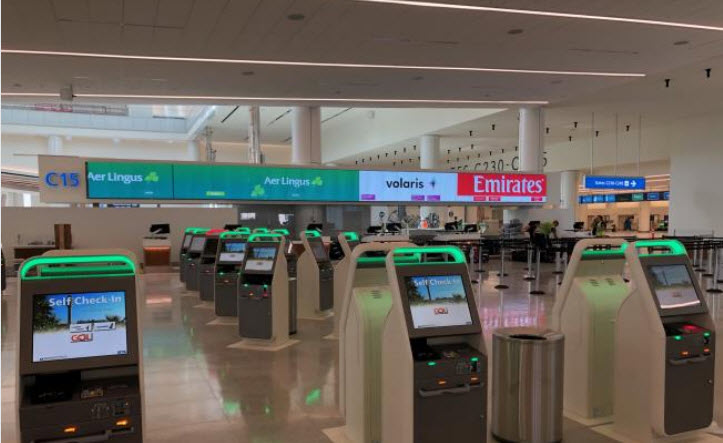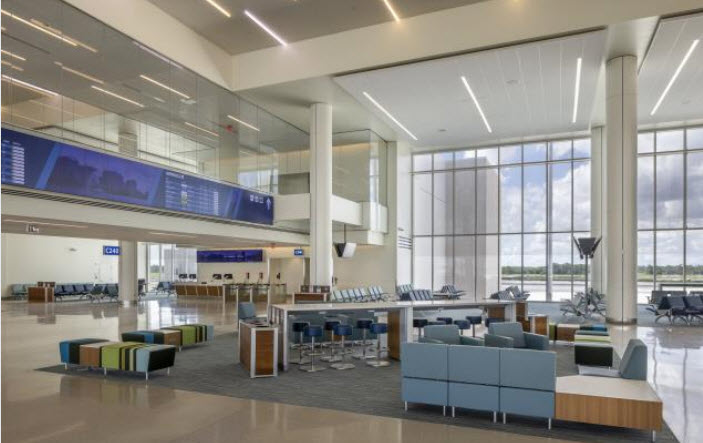Orlando International’s New Terminal C Arriving on Schedule


ORLANDO, FL. — When flights take off at Orlando International Airport’s new $2.8 billion Terminal C this September, it will mark a momentous occasion for the airport and the terminal’s designers and builders.
Although turning the airport’s vision into reality required navigating an unprecedented number of challenges, the end result is a facility that addresses the airport’s exponential growth and is prepared to serve an increasingly diverse mix of passengers seeking access to Central Florida.
Terminal C encompasses 300 acres and adds 15 gates capable of accommodating up to 20 aircraft, including narrow body, jumbo and super-jumbo jets, and includes informational video displays in the ticket halls, concession hub and gate areas plus interactive, immersive multimedia features that will provide high-definition visual entertainment. Designed for certification as one of the first LEED v4 airport campuses, Terminal C reflects Orlando International Airport’s (MCO) longstanding commitment to sustainability and environmental responsibility.
One of the unique aspects of Terminal C is its construction delivery structure. There are two construction managers at risk (CMAR), a design-build –operate-maintain (DBOM) baggage handling system and numerous design-build teams for the concessions and tenant build outs. While the entire Terminal C will operate as one building, Turner Kiewit CMAR team owned the landside of the expansion joint and the Hensel Phelps CMAR team owned the airside of the expansion joint. So while it is one building/one project, it was many teams working and owning the project together to ensure delivery was a success.
Greater Orlando Aviation Authority CEO Kevin Thibault says Terminal C is a direct reflection of GOAA’s commitment to the overall passenger experience. “We strive to use cutting-edge technology and best practices in everything we do,” Thibault says. “Above all else, we seek to recognize the many diverse types of passengers who use our airport.”
Turning Challenges into Opportunities
The 15-gate terminal was designed by Fentress Architects, in coordination with architect-of-record HNTB. A Turner-Kiewit joint venture and Hensel Phelps served as construction managers. The Netherlands-based Vanderlande Industries held the design-build-operate-maintain contract for the Baggage Handling System while Burns Engineering served as the project’s prime technology engineer.
Thibault has participated in numerous complex aviation projects over the years, but nothing compares to the teamwork he witnessed at Terminal C. “This was truly a team effort,” he says.
It was a project at a massive scale, with an average of more than 1,000 workers on site daily throughout construction of the terminal that required nearly 4 million cubic yards of dirt to be moved and more than 61,000 tons of steel put in place.
Delivering a project of this scope required a team and process built around a commitment to collaboration and coordination.
“It takes a village to build a project of this magnitude. One of the best decisions made early in the process by the Aviation Authority was to put all the project partners together on site which enhanced communication and ensured accountability,” says Bill Brooks, HNTB project director.
Ross Spence, senior program director at AECOM, the owner’s authorized representative, says the project team’s “co-location” significantly increased the speed in which decisions were made. Even during the worst of the pandemic constraints, they were able to continue meeting, while smaller meetings were conducted via Zoom and other platforms. “We had all of the major stakeholders in one location,” Spence says. “That made it a much easier task for a quick resolution.”
The construction process also gained efficiencies through an all-electronic permitting process that the City of Orlando implemented on the job site. Additionally, a decision tracking tool was integrated into the project by HNTB, which enabled the team to efficiently document and track decisions.
These tools helped keep the project timeline consistent, even in the face of fluctuating dynamics.
Phase 1 was originally designed to include 15 gates, then eventually included an expansion with four additional gates. However, when the COVID-19 pandemic impacted the airport in spring 2020, the airport paused the expansion, then later added the expansion back as airport traffic returned to pre-COVID levels.
Through it all, the deadline never moved. Matt Krstolic, operations manager at Hensel Phelps, says the late addition of the Phase 1 expansion was “like changing the transmission in a racecar in the middle of a race.”
Krstolic adds, “Having the conceptual designs already in a 3D BIM model enabled us to make adjustments on the fly and work with HNTB without delaying the project. We developed a process with HNTB in which we would come up with constructible solutions, put those through the RFI process and simultaneously coordinate and plan the path forward.”
Jeff Justen, vice president and business manager for Turner Construction Company, says the management of the Terminal C project was unparalleled. “Despite having to work through a variety of different impacts, the collective team pulled together to resolve all of the challenges,” he says.
GOAA’s forward-thinking approach also meant having a clear vision of the importance of technology features to create a world-class terminal environment. That was particularly helpful for the terminal’s state-of-the-art Baggage Handling System. Ion Apezteguia, executive project manager for Vanderlande Industries, says much of the system’s 7 miles of conveyors and associated equipment had been preordered and stored on site.
It was an industry first. “As soon as we had the design finalized, we sent everything to production,” Apezteguia says. “In six months, we had almost 300 containers being sent from our facilities all over the world to Orlando.” They were even able to “field proof” the system for the TSA.
Neil Hahn of Hahn Integrated Solutions, the owner’s representative during design and construction of the terminal’s low-voltage systems, says an abundance of owner-furnished technology had to be incorporated into the design as well.
He also credits teamwork for making it happen. “Every part of the team, including the contractor, designer, inspectors and subcontractors, sat in my trailer,” Hahn says. “It also helped to have a sophisticated owner and like-minded, positive professional people … all working together.”
As the project’s prime technology design consultant, Burns Engineering project manager Greg Spence led a team of a dozen engineers and eight sub-consultants. “Terminal C’s technology amenities put passengers in control of their airport journey. Features that enhance the passenger experience include common-use technologies, enhancements like automated Airport Screening Lanes, and mind-blowing immersive multimedia entertainment,” Spence says. “We anticipate passengers will particularly appreciate the convenience of the biometric facial and iris recognition gates that simplify the boarding process.”
Spence credits the team, led by GOAA as well as Hahn Integrated Solutions, HNTB and all the contractors, who came together to bring the technology features to life. “At Terminal C, the project’s designers and contractors worked together harmoniously, embedding our specialists within every step of the process.”
Through it all, the entire project team steadfastly supported small businesses, MWDBEs, LDBs and DBEs in the area. According to JC Arteaga, the HNTB architect of record, HNTB hired three minority associate architects from the local community and designated them as “architects of record” for the central energy plant, emergency power generator plant, checkpoints, parking garage and pedestrian bridge. Each of the CMs shared a similar commitment.
“We wanted that to be a legacy, so that when people look back they’ll say that the manner in which we engaged the community was a success,” Arteaga says.
Industry Firsts
As the newest airport terminal in the United States, Terminal C’s construction process has resulted, not only in a project that will finish on time and on budget, but a facility that integrates numerous features not previously seen at a U.S. airport:
Virtual ramp control for airline ground operations
- First fully integrated, multimodal airport terminal in the U.S. for rail, air and ground transportation
- 100% automated screening lanes at TSA checkpoint
- 100% facial recognition for arriving and departing international passengers
“Terminal C has been a highly complex project, driven by the latest technology and incorporating the industry’s most innovative systems,” says Davin Ruohomaki, senior director of Engineering and Construction at GOAA. “It is a testament to professionalism and teamwork that this project has progressed in an efficient and timely manner.”

